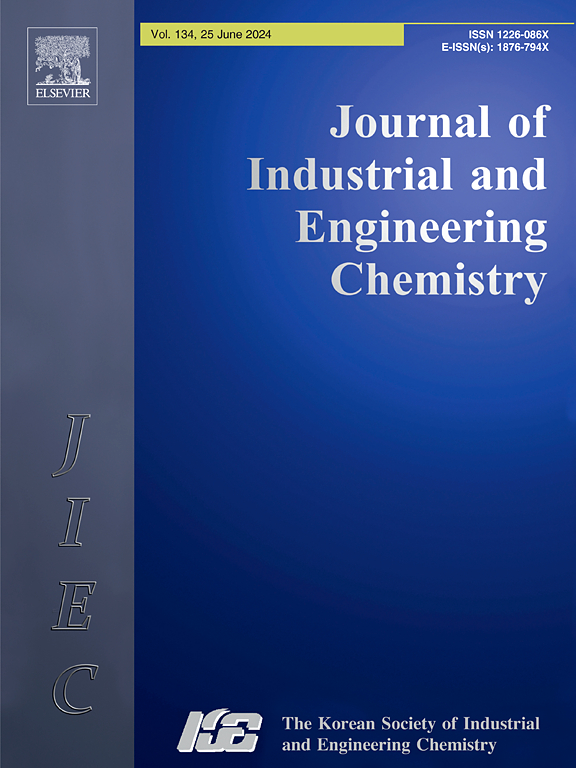CsPbBrxCl3-x/Cs4PbBrxCl6-x core/shell nanocrystals: Blue-emitting perovskite scintillators for X-ray detection
IF 5.9
3区 工程技术
Q1 CHEMISTRY, MULTIDISCIPLINARY
Journal of Industrial and Engineering Chemistry
Pub Date : 2025-01-30
DOI:10.1016/j.jiec.2025.01.034
引用次数: 0
Abstract
Metal halide perovskite nanocrystals have become a research hotspot in radiation detection due to their excellent optoelectronic properties. By embedding perovskite particles in an insulating matrix to form core/shell structure, their stability can be significantly enhanced. However, traditional solution synthesis methods have certain limitations in preparing core/shell structures with specific structures and compositions. In this research, a straightforward mechanochemical synthesis strategy was used to successfully prepare blue light emitting perovskite nanocrystals with CsPbBrxCl3-x as core and Cs4PbBrxCl6-x as shell. This method not only improved the luminescence efficiency of the nanocrystals (with the photoluminescence quantum yield (PLQY) increasing from 44.07% to 63.63%), but also enhanced their X-ray detection capabilities and stability. The excellent stability of the sample is attributed to the protection of Cs4PbBrxCl6-x, while the higher PLQY may be due to the passivation effect of the core/shell structure. During the synthesis process, effect of CsCl doping levels on the optical and structural properties of CsPbBrxCl3-x/Cs4PbBrxCl6-x NCs was investigated to optimize the synthesis scheme of the core/shell structure. In summary, this study paves the way for the further development and application of X-ray detection technology by thoroughly analyzing the effect of the core/shell structure on the environmental stability and detection performance.

CsPbBrxCl3-x/Cs4PbBrxCl6-x核/壳纳米晶体:用于x射线探测的蓝色钙钛矿闪烁体
金属卤化物钙钛矿纳米晶体以其优异的光电性能成为辐射探测领域的研究热点。通过将钙钛矿颗粒包埋在绝缘基质中形成核/壳结构,可以显著提高钙钛矿颗粒的稳定性。然而,传统的溶液合成方法在制备具有特定结构和组成的核/壳结构时存在一定的局限性。在本研究中,采用简单的机械化学合成策略,成功制备了以CsPbBrxCl3-x为核心,Cs4PbBrxCl6-x为壳层的蓝光钙钛矿纳米晶体。该方法不仅提高了纳米晶体的发光效率(光致发光量子产率(PLQY)从44.07%提高到63.63%),而且增强了纳米晶体的x射线探测能力和稳定性。样品的优异稳定性归功于Cs4PbBrxCl6-x的保护,而较高的PLQY可能是由于核/壳结构的钝化作用。在合成过程中,研究了CsCl掺杂水平对CsPbBrxCl3-x/Cs4PbBrxCl6-x NCs光学性能和结构性能的影响,优化了核壳结构的合成方案。综上所述,本研究通过深入分析核/壳结构对环境稳定性和检测性能的影响,为x射线检测技术的进一步发展和应用铺平了道路。
本文章由计算机程序翻译,如有差异,请以英文原文为准。
求助全文
约1分钟内获得全文
求助全文
来源期刊
CiteScore
10.40
自引率
6.60%
发文量
639
审稿时长
29 days
期刊介绍:
Journal of Industrial and Engineering Chemistry is published monthly in English by the Korean Society of Industrial and Engineering Chemistry. JIEC brings together multidisciplinary interests in one journal and is to disseminate information on all aspects of research and development in industrial and engineering chemistry. Contributions in the form of research articles, short communications, notes and reviews are considered for publication. The editors welcome original contributions that have not been and are not to be published elsewhere. Instruction to authors and a manuscript submissions form are printed at the end of each issue. Bulk reprints of individual articles can be ordered. This publication is partially supported by Korea Research Foundation and the Korean Federation of Science and Technology Societies.

 求助内容:
求助内容: 应助结果提醒方式:
应助结果提醒方式:


